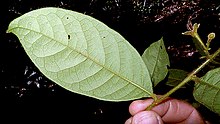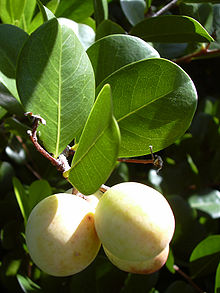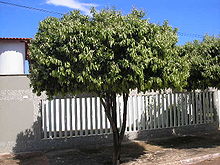Golden plum family
| Golden plum family | ||||||||||||
|---|---|---|---|---|---|---|---|---|---|---|---|---|

Tribus Couepieae: Maranthes polyandra , twigs with simple, leathery leaves and stone fruits |
||||||||||||
| Systematics | ||||||||||||
|
||||||||||||
| Scientific name | ||||||||||||
| Chrysobalanaceae | ||||||||||||
| R.Br. |
The gold plum family (Chrysobalanaceae) are a family in the order of the Malpighia-like (Malpighiales) within the flowering plants . The 16 to 18 genera with 400 to 525 species are particularly widespread in the tropics. Some species are used in many ways.
description








Appearance and leaves
There are always woody plants that rarely grow as shrubs or mostly trees . Only a few species develop buttress roots . The relatively slender, richly branched trunk has solid wood (leptocaul). There is a superficial cork cambium . The secondary growth in thickness is based on a conventional cambium ring . In many species, the main stem contains red resin .
The alternate and helical or two-line arranged leaves are divided into a petiole and a leaf blade. The mostly short petioles are usually swollen at one or both ends. A pair of glands are located on the petioles or at the base of the leaf blades. The simple leaf blade is pinnate. The undersides of the leaves can be bare or covered with simple hairs ( trichomes ). The blackish gray leaf veins can be seen particularly clearly in most species. There is often a mucous epidermis . The stomata are paracytic. There are always stipules present that are small and early falling to large and durable.
Inflorescences and flowers
The flowers are mostly hermaphroditic. But there are types that are andromonoeic or gynodioecan . The flowers are solitary or in many in terminal or lateral, simple or branched, zymose , paniculate or racemose inflorescences . There are bracts and usually two bracts under each flower .
The relatively small, weak to strong zygomorphen or radial symmetry flowers are fünfzählig, usually with double perianth (perianth). There is a short to long flower cup ( hypanthium ). In some species (mainly from Couepia , Hirtella , Maranthes ) the flower cup forms a short to long tube on the "mouth" of which the ovary is located. There is always a discus . The five sepals are fused with upright to curved back, often unequal calyx teeth that overlap like roof tiles. The five briefly nailed petals are fused with mostly unequal corolla lobes that overlap like roof tiles; they fall off early or are rarely absent. There are usually eight to numerous (20 to 200 or rarely up to 300), rarely only two stamens ( three to nine in Hirtella ), which are usually very unequal. The stamens are fused or free and sometimes stand together in bundles. The relatively small anthers are dorsifix and open with a longitudinal slit. The pollen grains usually have three, rarely four apertures and are colpat or colporat. Some of the stamens can be transformed into staminodes . There are one to three lower to upper permanent carpels present, either the bottom side or at the top (mouth) sitting in flower cups. Two are mostly more or less reduced; if there is more than one carpel, the carpel is fused into a syncarpic ovary . Each carpel has two ovules in basal placentation. The ovaries are sometimes divided into two compartments, each with only one ovule, by a false septum. The starting side or usually at the base of the ovary, thin stylus ends in a simple or ± distinct three-lobed stigma .
Fruits and seeds
The mostly relatively large stone fruits are rarely fleshy inside, but mostly dry. The thin to thick endocarp is fibrous or hard and often densely hairy on the inside. The epicarp is often hairy. There is usually only one stone core, rarely two. The relatively large embryo is well developed. The two cotyledons ( cotyledons ) are planokonvex and fleshy.
Ingredients and sets of chromosomes
There are proanthocyanidins: cyanidin or delphinidin . There are flavonols : kaempferol , quercetin , and / or myricetin present. There are silicates accumulated , especially the wood contains a lot of it. The seeds contain unsaturated fatty acids .
The basic chromosome number is x = 10 or 11.
ecology
Many species grow as large trees and form the top floor of the forest. With some Hirtella species, ant domatia for ants are formed at the base of the leaf blade .
The fruits are often spread by mammals such as bats , rats, monkeys. Species that thrive on rivers are drifted over the water or eaten by fish and thus spread. Few species are known to be spread by birds. In two species of Couepia , pollination is carried out by bats.





Systematics, botanical history and distribution
Taxonomy and Botanical History
The Chrysobalanaceae family was established by Robert Brown in 1818 in James Hingston Tuckey : Narrative of an expedition to explore the river Zaire: usually called the Congo, in South Africa, in 1816 , p. 433. Type genus is Chrysobalanus L. Synonyms for Chrysobalanaceae R.Br. are Hirtellaceae Horan. and Licaniaceae Martynov .
These taxa were previously published by, for example, Augustin-Pyrame de Candolle in Prodromus systematis naturalis regni vegetabilis 1825, Bentham and Hooker in Niger Flora 1849, Adolf Engler and Carl Prantl (eds.) In The natural plant families or John Hutchinson as subfamily Chrysobalanoideae or Tribus Chrysobalaneae R.Br. incorporated into the Rosaceae family . The Chrysobalanaceae family is an independent family in the order of the Malpighiales in the Angiosperm Phylogeny Group . The Chrysobalanaceae family is most closely related to the Trigoniaceae , Euphroniaceae, and Dichapetalaceae families .
According to Prance et al. 1969 and Prance & White 1988, according to morphological observations, the Chrysobalanaceae family was divided into the four tribe Chrysobalaneae R.Br. , Couepieae Prance & F.White , Hirtelleae Prance & F.White and Parinarieae Prance & F.White . This classification is not supported according to molecular genetic studies.
Occurrence
The species have their areas in the tropics , sometimes also subtropics , in large parts of the world. The most species-rich is the Neotropic ; Africa, including Madagascar, has the largest number of genera . Of the approximately 456 species, 365 occur in the Neotropic, 57 in Africa and 34 in Asia, Malesia and the Pacific islands. Many species thrive in lowland rainforests.
Genera and their distribution
The Chrysobalanaceae family contains 16 to 18 genera with 400 to 525 species:
-
Acioa Aubl. ( Syn .: Griffonia Hook. F. ): The three to six species are common in the Neotropic ; for example
- Acioa longipendula (Pilg.) Sothers & Prance
-
Afrolicania Mildbr. : It contains only one type:
- Niconussbaum ( Afrolicania elaeosperma Mildbr. ): The home is the tropical West Africa .
- Angelesia Korth. (Syn .: Trichocarya Miq. Nom. Superfl., Licania subg. Angelesia (Korth.) Prance & F.White , Coccomelia Ridl. ): The approximately three species occur from Thailand to New Guinea.
- Atuna Raf. (Syn .: Cyclandrophora Hassk. ): The eightor sospecies are distributed from India to the Pacific islands.
-
Bafodeya Prance ex F.White : It contains only one species:
- Bafodeya benna ( Scott-Elliot ) Prance ex F.White : It thrives at altitudes of 700 to 1000 meters in Guinea and Sierra Leone .
-
Golden plums ( Chrysobalanus L. ): The three species occur in the Neotropic and West Africa . Including:
- Coconut plum ( Chrysobalanus icaco L. ): There are two subspecies.
-
Cordillera C. Sothers & GTPrance : It was set up in 2016 and contains only one type:
- Cordillera platycalyx (Cuatrec.) Sothers & Prance :
- Couepia Aubl. (Syn .: Dulacia Neck. , Pleragina Arruda nom. Nud.): The 62 to 71 species are distributed from Mexico through Central America to tropical South America .
- Dactyladenia Welw. : The approximately 30 species are common to Africa.
- Exellodendron Prance : The approximately five species are common in northern South America.
- Gaulettia Sothers & Prance : The nine or so species are common in tropical South America. (According to Neotropikey 2009 there are no species in the Neotropic, maybe it's a synonym)
-
Geobalanus Small : It contains only one species:
- Geobalanus oblongifolius (Michx.) Small : It is found in the southeastern United States .
- Grangeria Comm. ex Juss. : The only two species occur in the western area of the Indian Ocean.
- Hirtella L. (Syn .: Brya Vell. , Causea Scop. , Salmasia Schreb. , Sphenista Raf. , Tachibota Aubl. , Thelyra Thouars , Zamzela Raf. ): The approximately 109 species are in the Neotropic (105 species) in Africa and common in Madagascar .
- Hunga Pancher ex Prance : The elevenor sospecies occur in New Guinea and New Caledonia .
-
Hymenopus (Benth.) Sothers & Prance : It contains only one species:
- Hymenopus latifolius (Benth. Ex Hook. F.) Sothers & Prance : This new combination took place in 2016.
- Kostermanthus Prance : There are about three types.
-
Leptobalanus (Benth.) Sothers & Prance : It contains only one species:
- Leptobalanus sprucei (Hook. F.) Sothers & Prance : This new combination took place in 2016. It occurs from Mexico to Panama and in Colombia.
-
Licania Aubl. (Syn .: Coccomelia Ridl. Nom. Illeg., Hedycrea Schreb. ): It is widespread in the Neotropic. It contained around 215 species by 2016, but this genus is paraphyletic to that extent. Over half of the species were spun off into other genera in 2016 and only around 100 species remain; including:
- Licania caldasiana Cuatrec. : It is considered extinct and occurred in Colombia.
- Magnistipula Engl .: The approximately 13 species are distributed in tropical Africa and Madagascar.
-
Maranthes flower (Syn .: Exitelia flower ): Ten of the twelve species occur in tropical Africa , one iswidespreadfrom Thailand to northern Australia and one species occurs from Nicaragua to Panama .
- Maranthes goetzeniana (Engl.) Prance : Southeast Africa, Tanzania, Mozambique and Zimbabwe.
- Microdesmia (Benth.) Sothers & Prance : It contains only two types.
- Moquilea Aubl. (Syn .: Dahuronia Scop. Nom. Superfl.): Some species belonged to Licania until 2016. The eight species since 2019 are distributed from Mexico to Central America and on the Caribbean islands to tropical South America.
-
Neocarya ( DC. ) Prance ex F.White : It contains only one species:
- Neocarya macrophylla ( Sabine ) Prance ex F.White : It grows in coastal savannas in West Africa.
- Parastemon A.DC. (Syn .: Diemenia Korth. ): The threeor sospecies come from the Nicobar Islands to Papuasia .
- Parinari Aubl. (Syn .: Balantium Desv. Ex Ham. , Dugortia Scop. , Lepidocarpa Korth. , Parinarium Juss. , Orth. Var., Petrocarya Schreb. ): The approximately 39 species are distributed in the tropics; about 18 species occur in the Neotropic.
- Parinariopsis (Huber) Sothers & Prance : It contains only one species.
use
Species from the Chrysobalanaceae family are widely used by the local population throughout the species' home ranges; for example for building houses, firewood, for charcoal, as food and in folk medicine . Although most of the species of Chrysobalanaceae are only used locally, there is potential for some more to be used in wood, food and the production of technical oils.
The fruits and seeds serve as food; sometimes only during periods of starvation. Some types are used to produce alcoholic beverages. The fruits of Chrysobalanus icaco are canned and filled with syrup and sold in Colombia and Venezuela under the name "Icacos". The fruits of some Neotropical species of the genera Couepia and Parinari are eaten (for example, the fruits of Chrysobalanus icaco and Acioa edulis are eaten). In Amboina the dish “Koku koku” is prepared from mashed seeds from Atuna excelsa mixed with raw or fried small fish, ginger, onions, chillies and lemon juice.
In the area of Malesia the standard name of the wood of the different genera of the Chrysobalanaceae is "Merbatu". Although the wood of so many species of the Chrysobalanaceae is potentially available, it is rarely used on a large scale. This is due to the high silicate content, which quickly dulls the saws. Since the wood of many species is resistant to wood-decomposing animals, it is used throughout the tropics for pillars in structures in the sea.
swell
- The family of Chrysobalanaceae in APWebsite . (Sections systematics and description)
- The Chrysobalanaceae family at DELTA by L. Watson & MJ Dallwitz. (Section description)
- The Chrysobalanaceae family in the Flora of Western Australia . (Section description)
- Ghillean T. Prance, Cynthia A. Sothers: Chrysobalanaceae 1: Chrysobalanus to Parinari and Chrysobalanaceae 2: Acioa to Magnistipula in Species plantarum. Flora of the World. , Parts 9 and 10, Australian Biological Resources, Canberra, 2003, ISBN 0-642-56832-4 and ISBN 0-642-56833-2 .
- Ghillean T. Prance, DJ Rogers, F. White A taximetric study of an Angiosperm family: generic delimitation in the Chrysobalanaceae. In: New Phytologist , Volume 68, Issue 4, 1969, pp. 1203-1234: (section history of systematics)
- Cynthia Sothers, Ghillean T. Prance, M. Chase: Towards a monophyletic Licania: a new generic classification of the polyphyletic Neotropical genus Licania (Chrysobalanaceae). In: Kew Bulletin , Volume 71, December 2016. doi : 10.1007 / s12225-016-9664-3
- Data sheet Chrysobalanaceae at Flora Malesiana .
Individual evidence
- ↑ a b The family of Chrysobalanaceae in APWebsite .
- ↑ a b c d e f g h i j k l m n o p q r s t u v w x y z aa ab ac ad ae af Ghillean T. Prance, Cynthia Sothers, 2009: Neotropical Chrysobalanaceae. on-line. In: W. Milliken, B. Klitgĺrd, A. Baracat (2009 onwards): Neotropikey - Interactive key and information resources for flowering plants of the Neotropics.
- ↑ a b c d e f g h i j k l Cynthia Sothers, Ghillean T. Prance, M. Chase: Towards a monophyletic Licania: a new generic classification of the polyphyletic Neotropical genus Licania (Chrysobalanaceae). In: Kew Bulletin , Volume 71, December 2016. doi : 10.1007 / s12225-016-9664-3
- ↑ a b c d e f g h i j k l m n o p q r s t u v w x Rafaël Govaerts: World Checklist of Seed Plants 1 (1, 2), 1995, pp. 1–483, 1– 529, MIM, Deurne. In: Rafaël Govaerts (ed.): Chrysobalanaceae. In: World Checklist of Selected Plant Families (WCSP) - The Board of Trustees of the Royal Botanic Gardens, Kew . Retrieved March 19, 2020.
- ↑ a b c d e f g h i j data sheet Chrysobalanaceae at Flora Malesiana .
- ↑ James Hingston Tuckey : Narrative of an expedition to explore the river Zaire: usually called the Congo, in South Africa, in 1816 . 1818, APPENDIX No. 5, p. 433 ( Robert Brown: Chrysobalanaceae on p. 433 in the Google book search).
- ↑ Chrysobalanaceae at Tropicos.org. Missouri Botanical Garden, St. Louis, accessed March 19, 2020.
- ↑ The Angiosperm Phylogeny Group: An update of the Angiosperm Phylogeny Group classification for the orders and families of flowering plants: APG III. In: Botanical Journal of the Linnean Society. Volume 161, Issue 2, 2009, pp. 105-121. doi: 10.1111 / j.1095-8339.2009.00996.x
- ↑ The Angiosperm Phylogeny Group: An update of the Angiosperm Phylogeny Group classification for the orders and families of flowering plants: APG IV . In: Botanical Journal of the Linnean Society. Volume 181, Issue 1, 2016, pp. 1-20. doi: 10.1111 / boj.12385
- ↑ Chrysobalanaceae in the Germplasm Resources Information Network (GRIN), USDA , ARS , National Genetic Resources Program. National Germplasm Resources Laboratory, Beltsville, Maryland. Retrieved May 27, 2019.
- ↑ a b Cynthia Sothers, Ghillean T. Prance: Resurrection of Angelesia, a Southeast Asian genus of Chrysobalanaceae. In: Blumea , Volume 59, 2014, pp. 103-105. doi : 10.3767 / 000651914X684880 full text PDF.
further reading
- Deepthi Yakandawala, Cynthia M. Morton, Ghillean T. Prance: Phylogenetic Relationships of the Chrysobalanaceae Inferred from Chloroplast, Nuclear, and Morphological Data. In: Annals of the Missouri Botanical Garden , Volume 97, Issue 2, 2010, pp. 259-281. doi : 10.3417 / 2007175
- Ghillean T. Prance: Flora Neotropica , Volume 009: Supplement: Chrysobalanaceae , 1989.
- Ghillean T. Prance, F. White: The Genera of Chrysobalanaceae: A Study in Practical and Theoretical Taxonomy and Its Relevance to Evolutionary Biology. In: Philosophical Transactions of the Royal Society of London , Series B, Biological Sciences, Volume 320, No. 1197, 1988, pp. 1-184: Abstract - Online.
Web links
- Chrysobalanaceae at Tropicos.org. In: IPCN Chromosome Reports . Missouri Botanical Garden, St. Louis
- The Chrysobalanaceae family in the Flora of Zimbabwe .
